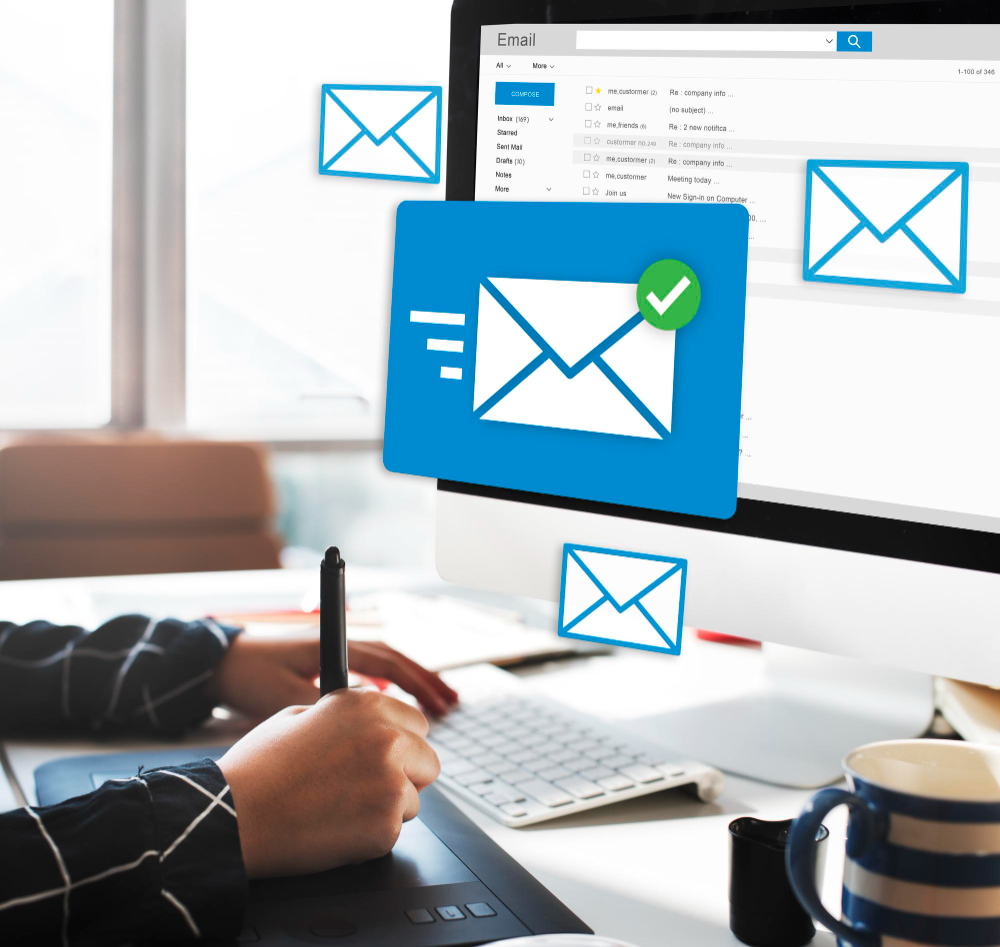What are the Email Marketing Strategies for Successful Campaigns?
Email marketing is a great tool for generating B2B leads and engaging customers.
Understanding efficient email marketing strategies may help B2B professionals in the United States, such as business owners, marketers, and decision-makers, improve campaign effectiveness.
This blog article discusses nine email marketing strategies for successful campaigns, increasing engagement, and driving conversions. Implementing these strategies can improve your results and guarantee your emails stand out in busy inboxes.
9 Email Marketing Strategies for Successful Campaigns
1# Personalize Your Emails
Personalization in email marketing goes beyond simply utilizing the recipient’s first name; it also includes adapting information to your audience’s tastes and habits. Begin by segmenting your email list based on criteria such as purchase history, geographic area, and user behavior.
For example, if a group on your list usually purchases a specific sort of goods, give them targeted suggestions and unique deals in that area. Use dynamic content blocks to show alternative pictures, offers, or messages depending on the recipient’s profile.
Personalized emails may foster a closer relationship with your target audience, resulting in more engagement. According to studies, customized emails increase click-through rates by 14% and conversions by 10%.
Personalization in automatic email sequences, such as welcome emails or cart abandonment reminders, may further improve the user experience by delivering relevant material at the appropriate moment.
Continuously providing relevant and valuable material fosters trust and loyalty among your subscribers, increasing their likelihood of engaging with your business.
2# Craft Compelling Subject Lines
The subject line of your email is essential in influencing whether it gets read or ignored. Creating appealing topic lines requires finding a balance between being informed and interesting.
Aim to express the email’s essential content or advantage briefly, preferably under 50 characters. Use action verbs and generate a sense of urgency or interest to persuade readers to read your email.
For example, subject lines like “Unlock Your Exclusive Offer Today” or “Don’t Miss Out on Our Latest Webinar” might elicit rapid attention. Also, avoid utilizing phrases that may activate spam filters, such as “free,” “buy now,” or numerous punctuation marks.
A/B testing different subject lines might give useful information on what resonates most with your audience. Analyze open rates to understand which sorts of subject lines perform best, and then utilize this information to improve your approach.
Personalizing subject lines with the recipient’s name or citing recent activities can help increase open rates. Remember, the subject line sets the tone for the email content, so make sure it matches the message and provides a clear indicator of the value within.
3# Optimize for Mobile Devices
With more than half of all emails being opened on mobile devices, optimizing your emails for mobile is no longer a choice; it is a need. Begin by designing a responsive email that adjusts to various screen sizes and orientations.
This guarantees that your email appears amazing on all devices, including smartphones, tablets, and desktops. Maintain a basic layout and avoid utilizing intricate designs or huge graphics, which might slow down download speeds.
Use a single-column layout to improve readability, and ensure that text and pictures are properly scaled for smaller displays. Make buttons and links large enough to be readily touched with a finger, and provide enough space between interactive components to avoid inadvertent clicks.
Test your emails on many devices and email clients to find and resolve any rendering issues. Consider the length of your subject lines and preview text; shorter versions are typically more appropriate for mobile displays.
Prioritizing mobile optimization allows you to deliver a smooth and engaging experience for consumers on the go, improving the probability of them reading and interacting with your emails.
4# Utilize Automation
Email automation is an effective technique for maintaining continuous communication with your audience while saving time and money. Setting up automatic processes allows you to deliver targeted messages depending on user activities or certain triggers.
For example, utilize automation to send welcome emails to new subscribers, nurturing sequences to guide leads through the sales funnel, and re-engagement efforts to reactivate dormant subscribers.
Automation also enables prompt follow-ups, such as sending a reminder email to consumers who have abandoned their shopping cart or a thank-you email following a purchase. Personalized automated emails can improve the user experience by delivering relevant material when it’s required.
Automated emails also have greater open and click-through rates than traditional newsletters since they are more relevant and current. To begin, plan out your client journey and identify important touchpoints where automated emails might add value.
Use an email marketing platform that supports automation and provides powerful analytics so you can analyze the efficacy of your automated campaigns and make required changes to ensure continual development.
5# Segment Your Audience
Segmentation is an important method for sending highly targeted and relevant email content to your subscribers.
Segmenting your email list based on certain characteristics allows you to tailor your communications to each segment’s distinct requirements and interests. Demographics (age, gender, geography), behavioral data (buy history, website activity), and degrees of engagement (active vs. inactive subscribers) are all common segmentation factors.
For example, you may identify a group of high-value consumers who make frequent purchases and provide them with special discounts or early access to new items. You may also target subscribers who haven’t read your emails in the last six months with a re-engagement campaign to get them back.
Create dynamic segments using your email marketing platform’s segmentation features, which will update in real-time as subscriber data changes. This guarantees that your parts remain current and relevant.
Delivering tailored content to each category may boost engagement, lower unsubscribe rates, and ultimately generate more conversions. Segmentation not only improves the user experience, but it also increases the overall success of your email marketing campaigns.
6# Provide Valuable Content
To keep your subscribers interested and coming back for more, you must include valuable material in your emails. Valuable content is educational, relevant, and targeted to the interests and demands of your target audience.
Begin by determining which kind of material your subscribers find most valuable. This may contain industry news, expert views, how-to guides, case studies, or special deals. Change up your material to keep it new and intriguing.
For example, in one email, you may give a client success story, followed by a practical suggestion or instructional. Use multimedia features such as photographs, infographics, and videos to make your emails more visually attractive and easy to read.
Consider offering special content that is not available anywhere else, such as downloadable resources or access to webinars and events. This not only offers value but also makes your subscribers feel unique and valued.
Always strive to create information that solves issues, answers questions, or offers actionable insights.
Continuously offering useful material establishes trust with your audience, positions your business as an industry leader, and cultivates long-term connections with your subscribers.
7# Implement a Clear Call to Action (CTA)
A clear and engaging call to action (CTA) is essential for directing your email readers to do the intended action, whether it’s visiting your website, downloading a resource, signing up for a webinar, or making a purchase.
To design a successful CTA, make it stand out visually from the rest of the email. Use a contrasting color for the CTA button and place it prominently in the email layout. Your CTA should be brief and action-oriented, using verbs that clearly express what the receiver will do, such as “Download Now,” “Register Today,” or “Get Your Free Trial.”
To reduce confusion and enhance the chance of conversion, focus your email on one core action you want your readers to perform rather than many CTAs. Also, analyze the email’s context and verify that the CTA is consistent with the overall message and value offer.
For example, in a welcome email, the CTA may be to explore your website or fill up their profile, but in a promotional email, it would be to take advantage of a limited-time offer. By making your CTAs clear and enticing, you may increase engagement and fulfill your campaign objectives.
8# Test and Analyze Performance
Continuous testing and analysis are essential for enhancing your email marketing efforts and increasing campaign success. A/B testing, also known as split testing, is sending two versions of an email to various portions of your audience to see which one performs better.
You may test several aspects of your emails, including subject lines, send timings, email content, CTAs, and design layouts. For example, you may test if a tailored subject line leads to greater open rates than a generic one.
Analyze your test results by comparing important data such as open rates, click-through rates, conversion rates, and unsubscribe rates. These insights might help you determine what connects with your target audience and tailor your approach accordingly.
Additionally, use the analytics tools supplied by your email marketing platform to monitor the overall effectiveness of your campaigns over time. Analyze your data for trends and patterns that might help you make future decisions.
Regularly assessing and altering your strategy based on performance data ensures that your email marketing is effective and meets your company goals.
9# Maintain Compliance and Best Practices
Compliance with email marketing standards and best practices is critical for keeping a positive sender reputation and creating trust with your target audience.
In the US, the CAN-SPAM Act mandates that commercial emails have a clear opt-out option, a genuine postal address, and correct sender information. To ensure compliance, always include an easy-to-find unsubscribe link in your emails and respond to opt-out requests immediately.
Avoid using misleading subject lines or false information that may mislead recipients about the email’s substance or intent. Furthermore, make sure that your email lists are generated legitimately, such as through opt-in forms on your website, rather than by purchasing lists, which might result in more spam complaints and harm your sender’s image.
Following email marketing best practices not only ensures compliance with rules, but also improves the overall success of your operations. Use double opt-in procedures to validate subscribers’ agreement and limit the number of spam complaints.
To maintain good deliverability rates, clean your email list regularly and remove inactive subscribers. Personalize your emails and segment your audience to keep your material fresh and interesting. Monitor important performance measures and constantly adjust your approach based on data insights.
Staying compliant and following best practices safeguards your brand’s reputation, creates trust with your audience, and achieves long-term success with your email marketing efforts.
Conclusion
Implementing these email marketing methods may greatly improve the efficacy of your campaigns.
You can increase engagement and conversions by personalizing your emails, creating compelling subject lines, optimizing for mobile devices, utilizing automation, segmenting your audience, providing valuable content, implementing clear CTAs, testing and analyzing performance, and adhering to compliance.
Stay up to speed on the newest trends and constantly tweak your email marketing strategies to guarantee your email marketing efforts are successful in the ever-changing digital world.




